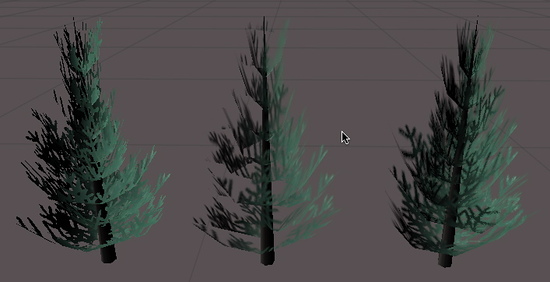ShaderLab syntax: Alpha testing
The alpha test is a last chance to reject a pixel from being written to the screen.

After the final output color has been calculated, the color can optionally have its alpha value compared to a fixed value. If the test fails, the pixel is not written to the display.
Syntax
- AlphaTest Off
- Render all pixels (default).
- AlphaTest comparison AlphaValue
- Set up the alpha test to only render pixels whose alpha value is within a certain range.
Comparison
Comparison is one of the following words:
| Greater | Only render pixels whose alpha is greater than AlphaValue. |
| GEqual | Only render pixels whose alpha is greater than or equal to AlphaValue. |
| Less | Only render pixels whose alpha value is less than AlphaValue. |
| LEqual | Only render pixels whose alpha value is less than or equal to from AlphaValue. |
| Equal | Only render pixels whose alpha value equals AlphaValue. |
| NotEqual | Only render pixels whose alpha value differs from AlphaValue. |
| Always | Render all pixels. This is functionally equivalent to AlphaTest Off. |
| Never | Don't render any pixels. |
AlphaValue
A floating-point number between 0 and 1. This can also be a variable reference to a float or range property, in which case it should be written using the standard square bracket notation ([VariableName]).
Details
The alpha test is important when rendering concave objects with transparent parts. The graphics card maintains a record of the depth of every pixel written to the screen. If a new pixel is further away than one already rendered, the new pixel is not written to the display. This means that even with Blending, objects will not show through.

In this figure, the tree on the left is rendered using AlphaTest. Note how the pixels in it are either completely transparent or opaque. The center tree is rendered using only Alpha Blending - notice how transparent parts of nearby branches cover the distant leaves because of the depth buffer. The tree on the right is rendered using the last example shader - which implements a combination of blending and alpha testing to hide any artifacts.
Examples
The simplest possible example, assign a texture with an alpha channel to it. The object will only be visible where alpha is greater than 0.5
Shader "Simple Alpha Test" {
Properties {
_MainTex ("Base (RGB) Transparency (A)", 2D) = "" {}
}
SubShader {
Pass {
// Only render pixels with an alpha larger than 50%
AlphaTest Greater 0.5
SetTexture [_MainTex] { combine texture }
}
}
}
This is not much good by itself. Let us add some lighting and make the cutoff value tweakable:
Shader "Cutoff Alpha" {
Properties {
_MainTex ("Base (RGB) Transparency (A)", 2D) = "" {}
_Cutoff ("Alpha cutoff", Range (0,1)) = 0.5
}
SubShader {
Pass {
// Use the Cutoff parameter defined above to determine
// what to render.
AlphaTest Greater [_Cutoff]
Material {
Diffuse (1,1,1,1)
Ambient (1,1,1,1)
}
Lighting On
SetTexture [_MainTex] { combine texture * primary }
}
}
}
When rendering plants and trees, many games have the hard edges typical of alpha testing. A way around that is to render the object twice. In the first pass, we use alpha testing to only render pixels that are more than 50% opaque. In the second pass, we alpha-blend the graphic in the parts that were cut away, without recording the depth of the pixel. We might get a bit of confusion as further away branches overwrite the nearby ones, but in practice, that is hard to see as leaves have a lot of visual detail in them.
Shader "Vegetation" {
Properties {
_Color ("Main Color", Color) = (.5, .5, .5, .5)
_MainTex ("Base (RGB) Alpha (A)", 2D) = "white" {}
_Cutoff ("Base Alpha cutoff", Range (0,.9)) = .5
}
SubShader {
// Set up basic lighting
Material {
Diffuse [_Color]
Ambient [_Color]
}
Lighting On
// Render both front and back facing polygons.
Cull Off
// first pass:
// render any pixels that are more than [_Cutoff] opaque
Pass {
AlphaTest Greater [_Cutoff]
SetTexture [_MainTex] {
combine texture * primary, texture
}
}
// Second pass:
// render in the semitransparent details.
Pass {
// Dont write to the depth buffer
ZWrite off
// Don't write pixels we have already written.
ZTest Less
// Only render pixels less or equal to the value
AlphaTest LEqual [_Cutoff]
// Set up alpha blending
Blend SrcAlpha OneMinusSrcAlpha
SetTexture [_MainTex] {
combine texture * primary, texture
}
}
}
}
Note that we have some setup inside the SubShader, rather than in the individual passes. Any state set in the SubShader is inherited as defaults in passes inside it.
Page last updated: 2008-04-27